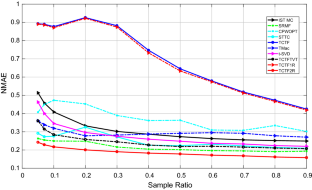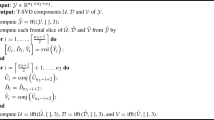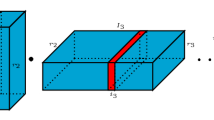Abstract
Recovery of network traffic data from incomplete observed data is an important issue in internet engineering and management. In this paper, by fully combining the temporal stability and periodicity features in internet traffic data, a new separable optimization model for internet data recovery is proposed, which is based upon the T-product factorization and the rapid discrete Fourier transform of tensors. The separable structural features presented in the model provide the possibility to design more efficient parallel algorithms. Moreover, by using generalized inverse matrices, an easy-to-operate and effective algorithm is proposed. In theory, we prove that under suitable conditions, every accumulation point of the sequence generated by the proposed algorithm is a stationary point of the established model. Numerical simulation results carried on the widely used real-world internet network datasets, show that the proposed method outperforms state-of-the-art competitions.







Similar content being viewed by others
References
Acar, E., Dunlavy, D.M., Kolda, T.G., Mørup, M.: Scalable tensor factorizations for incomplete data. Chemom. Intell. Lab. Syst. 106, 41–56 (2011)
Alderson, D., Chang, H., Roughan, M., Uhlig, S., Willinger, W.: The many facets of internet topology and traffic. Netw. Heterog. Media 1(4), 569–600 (2006)
Beck, A., Tetruashvili, L.: On the convergence of block corrdinate descent type methods. SIAM J. Optim. 23, 2037–2060 (2013)
Ben-Israel, A., Greville, T.N.E.: Generalized Inverses: Theory and Applications, 2nd edn. Springer, New York (2003)
Bernstein, D.S.: Matrix Mathematics: Theory, Facts, and Formulas, 2nd edn. Princeton University Press, Princeton and Oxford (2008)
Bertsekas, D.P.: Nonlinear Programming, 2nd edn. Athena Scientific, Belmont, MA (1999)
Brandwood, D.H.: A complex gradient operator and its application in adaptive array theory. IEE Proc. H Microwav. Opt. Antennas 130(1), 11–16 (1983)
Cahn, R.S.: Wide Area Network Design. Morgan Kaufman, San Mateo, CA (1998)
Candés, E.J., Recht, B.: Exact matrix completion via convex optimization. Found. Comput. Math. 9(6), 717–772 (2009)
Carroll, J.D., Chang, J.J.: Analysis of individual differences in multidimensional scaling via an \(n\)-way generalization of ‘Eckart-Young’ decomposition. Psychometrika 35(3), 283–319 (1970)
Chen, Y.C., Qiu, L., Zhang, Y., Xue, G., Hu, Z.: Robust network compressive sensing. In: Proceedings of the 20th Annual International Conference on Mobile Computing and Networking, pp. 545–556 (2014)
Da Silva, C., Herrmann, F.J.: Optimization on the hierarchical Tucker manifold-applications to tensor completion. Linear Algebra Appl. 481, 131–173 (2015)
Du, R., Chen, C., Yang, B., Guan, X.: VANET based traffic estimation: a matrix completion approach. In: IEEE Global Communications Conference, pp. 30–35 (2013)
Gandy, S., Recht, B., Yamada, I.: Tensor completion and low-\(n\)-rank tensor recovery via convex optimization. Inverse Probl. 27(2), 025010 (2011)
Golub, G.H., Van Loan, C.F.: Matrix Computations, 4th edn. Johns Hopkins University Press, Baltimore (2013)
Gürsun, G., Crovella, M.: On traffic matrix completion in the internet. In: Proceedings of the ACM SIGCOMM Internet Measurement Conference, pp. 399-412 (2012)
Hao, N., Kilmer, M.E., Braman, K., Hoover, R.C.: Facial recognition using tensor–tensor decompositions. SIAM J. Imaging Sci. 6(1), 437–463 (2013)
Harshman, R.A.: Foundations of the PARAFAC procedure: models and conditions for an ‘explanatory’ multi-modal factor analysis. UCLA Work Papers Phonetics 16(1), 1–84 (1970)
Horn, R.A., Johnson, C.R.: Topics in Matrix Analysis. Cambridge University Press (1994)
Irawati, I.D., Suksmono, A.B., Edward, I.J.M.: Missing internet traffic reconstruction using compressive sampling. Int. J. Commun. Netw. Inf. Secur. 9(1), 57–66 (2017)
Jiang, T.X., Huang, T.Z., Zhao, X.L., Ji, T.Y., Deng, L.J.: Matrix factorization for low-rank tensor completion using framelet prior. Inf. Sci. 436–437, 403–417 (2018)
Kilmer, M.E., Martin, C.D.: Factorization strategies for third-order tensors. Linear Algebra Appl. 435, 641–658 (2011)
Kilmer, M.E., Braman, K., Hao, N., Hoover, R.C.: Third-order tensors as operators on matrices: a theoretical and computational framework with applications in imaging. SIAM J. Matrix Anal. Appl. 34, 148–172 (2013)
Lakhina, A., Papagiannaki, K., Crovella, M., Diot, C., Kolaczyk, E.D., Taft, N.: Structural analysis of network traffic flows. In: ACM SIGMETRICS Performance Evaluation Review, pp. 61–72 (2004)
Liao, Y., Du, W., Geurts, P., Leduc, G.: DMFSGD: a decentralized matrix factorization algorithm for network distance prediction. IEEE/ACM Trans. Netw. 21(5), 1511–1524 (2013)
Lin, X.L., Ng, M.K., Zhao, X.L.: Tensor factorization with total variation and tikhonov regularization for low-rank tensor completion in imaging data. J. Math. Imaging Vis. 62(6), 900–918 (2020)
Majumdar, A.: Matrix Completion via Thresholding. MATLAB Central File Exchange. Retrieved April 2 (2020)
Mardani, M., Giannakis, G.B.: Robust network traffic estimation via sparsity and low rank. In: IEEE International Conference on Acoustics, Speech and Signal Processing, pp. 4529–4533 (2013)
Ming, Z., Zhang, L., Xu, Y., Bakshi, M.: An algorithm for matrix recovery of high-loss-rate network traffic data. Appl. Math. Modell. 96, 645–656 (2021)
Nie, L., Jiang, D., Guo, L.: A power laws-based reconstruction approach to end-to-end network traffic. J. Netw. Comput. Appl. 36(2), 898–907 (2013)
Patwardhan, K.A., Sapiro, G., Bertalm, M.: Video inpainting under constrained camera motion. IEEE Trans. Image Process. 16, 545–553 (2007)
Roughan, M., Thorup, M., Zhang, Y.: Traffic engineering with estimated traffic matrices. In: Proceedings of the ACM IMC, pp. 248–258 (2003)
Roughan, M., Zhang, Y., Willinger, W., Qiu, L.: Spatio-temporal compressive sensing and internet traffic matrices (extended version). IEEE/ACM Trans. Netw. 20, 662–676 (2012)
Sauve, A.C., Hero, A.O., Rogers, W.L., Wilderman, S.J., Clinthorne, N.H.: 3d image reconstruction for a compton spect camera model. IEEE Trans. Nuclear Sci. 46, 2075–2084 (1999)
Shang, K., Li, Y.F., Huang, Z.H.: Iterative \(p\)-shrinkage thresholding algorithm for low Tucker rank tensor recovery. Inf. Sci. 482, 374–391 (2019)
The Abilene observatory data collections. Accessed May 2004. http://abilene.internet2.edu/observatory/data-collections.html
Thompson, R.C.: Inertial properties of eigenvalues II. J. Math. Anal. Appl. 58, 572–577 (1977)
Tucker, L.: Some mathematical notes on three-mode factor analysis. Psychometrika 31(3), 279–311 (1966)
Tune, P., Roughan, M.: Internet traffic matrices: a Primer. In: Haddadi, H., Bonaventure, O. (eds.), Recent Advances in Networking, vol. 1, pp. 1–56 (2013)
Uhlig, S., Quoitin, B., Lepropre, J., Balon, S.: Providing public intradomain traffic matrices to the research community. ACM SIGCOMM Comput. Commun. Rev. 36, 83–86 (2006)
Vardi, Y.: Network tomography: estimating source–destination traffic intensities from link data. J. Am. Stat. Assoc. 91(433), 365–377 (1996)
Varghees, V.N., Manikandan, M.S., Gini, R.: Adaptive MRI image denoising using total-variation and local noise estimation. In: Proceedings of the 2012 International Conference on Advances in Engineering, Science and Management (ICAESM), pp. 506–511 (2012)
Xie, K., Peng, C., Wang, X., Xie, G., Wen, J., Cao, J., Zhang, D., Qin, Z.: Accurate recovery of internet traffic data under variable rate measurements. IEEE/ACM Trans. Netw. 26, 1137–1150 (2018)
Xie, K., Wang, L., Wang, X., Xie, G., Zhang, G.X., Xie, D.L., Wen, J.: Sequential and adaptive sampling for matrix completion in network monitoring systems. In: Proceedings of the IEEE INFOCOM, pp. 2443–2451 (2015)
Xu, Y., Hao, R., Yin, W., Su, Z.: Parallel matrix factorization for low-rank tensor completion. Inverse Probl. Imaging 9(2), 601–624 (2015)
Yang, L., Huang, Z.H., Hu, S.L., Han, J.Y.: An iterative algorithm for third-order tensor multi-rank minimization. Comput. Optim. Appl. 63, 169–202 (2016)
Zhang, Z., Ely, G., Aeron, S., Hao, N., Kilmer, M.: Novel methods for multilinear data completion and de-noising based on tensor-SVD. In: 2014 IEEE Conference on Computer Vision and Pattern Recognition, pp. 3842-3849 (2014)
Zhou, P., Lu, C.Y., Lin, Z.C., Zhang, C.: Tensor factorization for low-rank tensor completion. IEEE Trans. Image Process. 3, 1152–1163 (2018)
Zhou, H., Zhang, D., Xie, K., Chen, Y.: Spatio-temporal tensor completion for imputing missing internet traffic data. In: IEEE 34th International Performance Computing and Communications Conference (IPCCC) (2015)
Zhu, R., Liu, B., Niu, D., Li, Z., Zhao, H.V.: Network latency estimation for personal devices: a matrix completion approach. IEEE/ACM Trans. Netw. 25(2), 724–737 (2017)
Acknowledgements
C. Ling and G. H. Yu were supported in part by National Natural Science Foundation of China (Nos. 11971138, 12071104 and 11661007) and Natural Science Foundation of Zhejiang Province (Nos. LY19A010019 and LD19A010002).
Author information
Authors and Affiliations
Corresponding author
Additional information
Publisher's Note
Springer Nature remains neutral with regard to jurisdictional claims in published maps and institutional affiliations.
Appendix
Appendix
1.1 A. Proofs of Propositions
We begin with recalling the following lemmas, which are used to analyze convergence properties of TCTF2R Algorithm.
Lemma 6.1
[4] Let \(A\in {\mathbb {C}}^{m\times n}\) and \(B=UAV^H\), where \(U\in {\mathbb {C}}^{m\times m}\) and \(V\in {\mathbb {C}}^{n\times n}\) are unitary. Then \(B^+=VA^+U^H\). In particular, if \(USV^H\) is the singular-value decomposition (SVD) of A, where \(S=\mathrm{diag}(\sigma _{1},\ldots ,\sigma _{t},0,\ldots ,0)\in {\mathbb {C}}^{m\times n}\) with \(\sigma _{1}\ge \ldots \ge \sigma _{t}>0\), then \(A^+=VS^{-1}U^H\), where \(S^{-1}=\mathrm{diag}(\sigma ^{-1}_{1},\ldots ,\sigma ^{-1}_{t},0,\ldots ,0)\in {\mathbb {C}}^{m\times n}\).
Lemma 6.2
[5] Let \(A\in {\mathbb {C}}^{m\times m}\) be a Hermitian matrix with eigenvalues \(\alpha _1\ge \ldots \ge \alpha _m\). Then, it holds that \(\alpha _m\mathrm{tr}(B)\le \mathrm{tr}(AB) \le \alpha _1\mathrm{tr}(B)\) for any given positive semidefinite Hermitian matrix \(B\in {\mathbb {C}}^{m\times m}\).
Lemma 6.3
[37] Let \(C=B^HAB\) with eigenvalues \(\lambda _1\ge \ldots \ge \lambda _n\), where \(A\in {\mathbb {C}}^{m\times m}\) is a Hermitian matrix with eigenvalues \(\alpha _1\ge \ldots \ge \alpha _m\ge 0\), and \(B\in {\mathbb {C}}^{m\times n}\) with singular values \(\beta _1\ge \ldots \ge \beta _n\ge 0\), i.e., the eigenvalues of the positive semidefinite matrix \((B^HB)^{1/2}\). Then the following statements hold
-
1.
\(\lambda _{i+j-1}\le \beta _i^2\alpha _j\), for every \(1\le i\le n\), \(1\le j\le m\) and \(i+j-1\le n\).
-
2.
\(\beta _i^2\alpha _j\le \lambda _{i+j-m}\), for every \(1\le i\le n\), \(1\le j\le m\) and \(i+j>m\).
1.2 A.1 Proof of Proposition 4.2
Proof
We first prove (4.7). For writing concisely, the subscript letter \({\tilde{Y}}\) in this proposition are omitted in our proof. Since \(U^{(l)}S^{(l)}(V^{(l)})^H\) is the SVD of \({\tilde{Y}}^{(l)}\), we have \({\tilde{Y}}^{(l)}({\tilde{Y}}^{(l)})^H=U^{(l)}{\tilde{S}}^{(l)}(U^{(l)})^H\), where \({\tilde{S}}^{(l)}=S^{(l)}(S^{(l)})^\top =\mathrm{diag}({\tilde{S}}_1^{(l)},O)\), \({\tilde{S}}_1^{(l)}=\mathrm{diag}(\sigma ^2_{l1},\ldots ,\sigma ^2_{lt})\in {\mathbb {C}}^{t\times t}\) and \(O\in {\mathbb {C}}^{(r-t)\times (r-t)}\) is a zero matrix. Consequently, by Lemma 6.1, it holds that
where \(({\tilde{S}}^{(l)})^{+}=\mathrm{diag}(({\tilde{S}}_1^{(l)})^{-1},O)\) and \(({\tilde{S}}_1^{(l)})^{-1}=\mathrm{diag}(\sigma ^{-2}_{l1},\ldots ,\sigma ^{-2}_{lt})\). For simplicity, we write \(R_{U1}^{(l)}=\nabla _{{\tilde{X}}}h_k({\tilde{X}}^{(l)},{\tilde{Y}}^{(l)}) U^{(l)}_1\) and \(R_{U2}^{(l)}=\nabla _{{\tilde{X}}}h_k({\tilde{X}}^{(l)},{\tilde{Y}}^{(l)}) U^{(l)}_2\). Then, by (4.1), (4.4) and (6.1), we know \(d_{{\tilde{X}}}^{(l)} =-H_{\rho _1}^{-1}[R_{U1}^{(l)},R_{U2}^{(l)}]({\tilde{S}}^{(l)})^{+} (U^{(l)})^H\), which implies
It is clear that \(H_{\rho _1}^{-1}\) and \(({\tilde{S}}_1^{(l)})^{-1}\) are positive definite. Consequently, by (6.2), Proposition 4.1 and Lemma 6.2, it holds that
From this, we obtain the desired result (4.7), since \(R_{U1}^{(l)}=\nabla _{{\tilde{X}}}h_k({\tilde{X}}^{(l)},{\tilde{Y}}^{(l)}) U^{(l)}_1\).
By Proposition 4.1 and Lemmas 6.1–6.3, we can obtain (4.8) similarly. We complete the proof. \(\square\)
1.3 A.2 Proof of Proposition 4.3
Proof
Since \({\tilde{Y}}^{(l)}\) is of full row rank, by (4.5), it holds that
which implies that
Consequently, by Lemma 6.3, the first inequality in (4.12) follows. The second inequality can be proved similarly. \(\square\)
1.4 A.3 Proof of Proposition 4.4
Proof
Since \(g_{k}(W^{(l+1)}_k)\le g_{k}(W^{(l)}_k)\), we have
We obtain the desired result and complete the proof. \(\square\)
1.5 A.4 Proof of Proposition 4.5
Proof
By Lemma 4.1, we have
where \(L_{1}^{(l)}=L_{1}({\tilde{Y}}^{(l)})\). Consequently, since \(L_{1}^{(l)}\le (1+4\rho _1)\sigma ^2_{{\tilde{Y}}l1}\), by (4.10) and the first express in (4.12), we obtain
where \(\tau _{X_l}=(2\sigma ^4_{{\tilde{Y}}lt}-(1+4\rho _1)^2 \sigma ^4_{{\tilde{Y}}l1}) /(2(1+4\rho _1)\sigma ^2_{{\tilde{Y}}l1}\sigma ^4_{{\tilde{Y}}lt})\). Similarly, we have
where \(\tau _{Yl}=(2\sigma ^4_{{\tilde{X}}ls}-(1+4\rho _1)^2 \sigma ^4_{{\tilde{X}}l1})/(2(1+4\rho _1)\sigma ^2_{{\tilde{X}}l1} \sigma ^4_{{\tilde{X}}ls})\). By summing the two inequalities above, we obtain the desired result and complete the proof. \(\square\)
1.6 A.5 Proof of Proposition 4.6
Proof
Since \(L_{1}^{(l)}\le (1+4\rho _1)\sigma ^2_{{\tilde{Y}}l1}\), it is obvious that
which implies, together with the first inequality in (4.12), that
Consequently, by using a similar way to that in [3], we have
where the last inequality is due to (6.3). Therefore, we further obtain
which implies, together with Proposition 4.5, that we have obtained (4.15) and complete the proof. \(\square\)
Rights and permissions
About this article
Cite this article
Ling, C., Yu, G., Qi, L. et al. T-product factorization method for internet traffic data completion with spatio-temporal regularization. Comput Optim Appl 80, 883–913 (2021). https://doi.org/10.1007/s10589-021-00315-1
Received:
Accepted:
Published:
Issue Date:
DOI: https://doi.org/10.1007/s10589-021-00315-1




